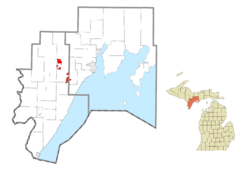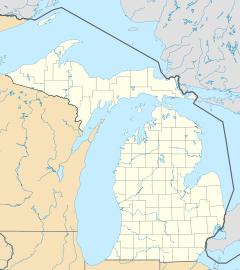Hannahville Indian Community facts for kids
Quick facts for kids
Hannahville Indian Community
|
|
|---|---|

Locations within Menominee County (left) and Delta County (right)
|
|
| Country | United States |
| State | Michigan |
| Counties | Delta and Menominee |
| Founded | 1884 |
| Government | |
| • Type | Tribal council |
| Population
(2013)
|
|
| • Total | 891 |
| Time zone | UTC−6 (Central (CST)) |
| • Summer (DST) | UTC−5 (CDT) |
| ZIP code(s) |
49807
|
| Area code(s) | 906 |
The Hannahville Indian Community is a Potawatomi tribe that is officially recognized by the United States government. They live in Michigan's Upper Peninsula, about 15 miles west of Escanaba. Their home is an Indian reservation that covers about 8.5 square miles.
Most of the reservation is in Harris Township in Menominee County. Smaller parts are in Gourley Township (also in Menominee County) and Bark River Township in nearby Delta County. In 2020, about 720 people lived here, and most were of Native American heritage. As of 2013, the tribe had 891 official members.
Contents
The Potawatomi People's Journey
The people of Hannahville are descendants of Potawatomi people who chose to stay in Michigan. This was during a time in 1834 when many Native American tribes were forced to move far away to what was called Indian Territory.
For a while, some Potawatomi lived outside Michigan. They stayed with the Menominee people in northern Wisconsin. They also lived with the Ojibwe and Ottawa peoples in Canada. The Potawatomi, Ojibwe, and Odawa were part of a special alliance called the Council of the Three Fires.
In 1853, some Potawatomi returned to Michigan. They settled near the mouth of the Big Cedar River by Lake Michigan.
How Hannahville Got Its Name
A church minister named Peter Marksman was sent to help the community. He is known for finding the land where the Potawatomi now live. He helped them move to this new location.
Church records say that the Potawatomi people really liked Marksman's wife, Hannah. Because of their fondness for her, they decided to name their new community "Hannahville" after her.
Hannahville's Government and Growth
The US federal government first officially recognized this area as Potawatomi land in 1870. The reservation itself was officially created by a law passed by Congress in 1913.
Forming a Tribal Government
In 1934, a law called the Indian Reorganization Act of 1934 was passed. This law helped tribes create their own governments. The Hannahville tribe wrote their own constitution and set up an elected government. The federal government officially recognized their new government in 1937.
Today, the community is led by a 12-person Tribal Council. Members of the tribe elect these council members. The council makes important decisions for the community.
Working Together with Other Tribes
In 1966, the Hannahville tribe joined with three other tribes in Michigan. They created the Inter-Tribal Council of Michigan, Inc.. The other founding members were the Keweenaw Bay Indian Community, Bay Mills Indian Community, and Saginaw Chippewa Indian Tribe.
These tribes wanted to work together for everyone's benefit. They aimed to manage joint projects and improve their relationships with the state and federal governments.
Bringing Electricity to the Reservation
In 1966, the Hannahville reservation got electricity for the very first time! This was a big project called the "Lights for Christmas Project." Many groups worked together to make it happen. These groups included UPCAP, the Community Action Agency, the Bureau of Indian Affairs, and the Marquette Catholic Diocese.
In December 1966, workers from the Alger-Delta Cooperative Electric Association started installing power lines. They ran the lines about 5 miles from the Harris area to the Hannahville Indian Reservation. The installation was finished on December 23, 1966.
A Community Effort
A team of 40 volunteer electricians from all over Michigan helped out. They were all members of the International Brotherhood of Electricians. These volunteers wired 16 homes on the reservation so they could receive electricity.
All 16 homes were ready for power late that evening. On December 23, 1966, at 3 p.m., local officials and community members watched. The "hotlines" were turned on at Hannahville for the first time, bringing light and power to the homes.
The Marquette Catholic Diocese donated $6,000 to help with the project. Each of the 16 families who received electricity paid a small membership fee of $5 to the electric cooperative.
Where Hannahville is Located
According to the United States Census Bureau, the Hannahville Indian Community covers about 5.57 square miles of land. The community also has about 3.57 square miles of "off-reservation trust land." This means it's land owned by the tribe but not directly part of the main reservation.
When you combine the reservation and the off-reservation trust land, the total area is about 9.14 square miles.
Who Lives in Hannahville
The census of 2020 counted 720 people living in the Hannahville Indian Community and its off-reservation trust land. Of these residents, 325 lived within the main community area. Another 395 people lived on the off-reservation trust land.
Most of the people living there are Native American (75.1%). Other groups include White people (13.1%) and people of two or more races (11.5%). A small number of people are Hispanic or Latino (2.4%).
The tribe is also working to protect the environment. They want to make sure the land stays healthy and safe for people now and in the future.
Education in Hannahville
The tribal school for the community is called Hannahville Indian School.


